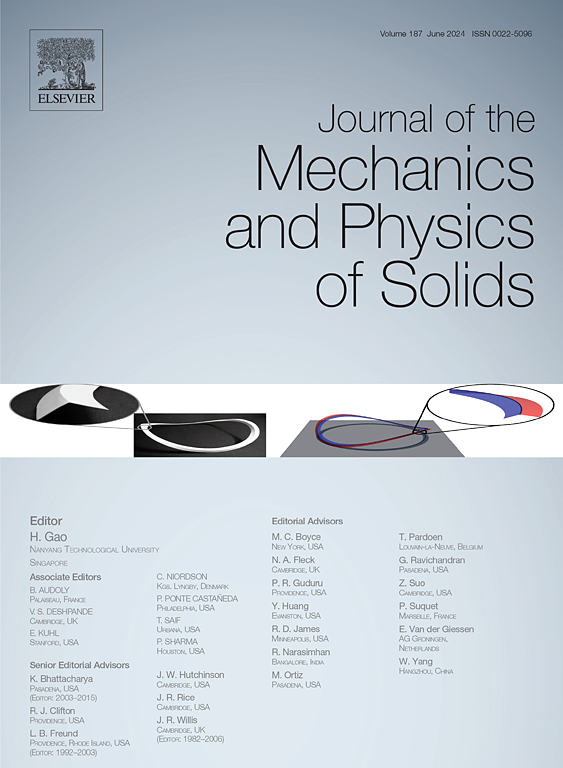Towards understanding structure-function relationships in random fiber networks
IF 6
2区 工程技术
Q2 MATERIALS SCIENCE, MULTIDISCIPLINARY
引用次数: 0
Abstract
Random fiber networks form the structural foundation of numerous biological tissues and engineered materials. From a mechanics perspective, understanding the structure-function relationships of random fiber networks is particularly interesting because when external force is applied to these networks, only a small subset of fibers will actually carry the majority of the load. Specifically, these load-bearing fibers propagate through the network to form load paths, also called force chains. However, the relationship between fiber network geometric structure, force chains, and the overall mechanical behavior of random fiber network structures remains poorly understood. To this end, we implement a finite element model of random fiber networks with geometrically exact beam elements, and use this model to explore random fiber network mechanical behavior. Our focus is twofold. First, we explore the mechanical behavior of single fiber chains and random fiber networks. Second, we propose and validate an interpretable analytical approach to predicting fiber network mechanics from structural information alone. Key findings include insight into the critical strain-stiffening transition point for single fiber chains and fiber networks generated from a Voronoi diagram, and a connection between force chains and the distance-weighted graph shortest paths that arise by treating fiber networks as spatial graph structures. This work marks an important step towards mapping the structure-function relationships of random fiber networks undergoing large deformations. Additionally, with our code distributed under open-source licenses, we hope that future researchers can directly build on our work to address related problems beyond the scope defined here.
迈向理解随机光纤网络中的结构-功能关系
随机纤维网络构成了许多生物组织和工程材料的结构基础。从力学的角度来看,理解随机纤维网络的结构-功能关系是特别有趣的,因为当外力施加到这些网络上时,只有一小部分纤维实际上承担了大部分载荷。具体地说,这些承重纤维通过网络传播形成负载路径,也称为力链。然而,纤维网络几何结构、力链和随机纤维网络结构的整体力学行为之间的关系仍然知之甚少。为此,我们实现了具有几何精确梁单元的随机光纤网络的有限元模型,并利用该模型来探索随机光纤网络的力学行为。我们的重点是双重的。首先,我们探讨了单纤维链和随机纤维网络的力学行为。其次,我们提出并验证了一种仅从结构信息预测纤维网络力学的可解释分析方法。主要发现包括洞察单纤维链和由Voronoi图生成的纤维网络的关键应变硬化过渡点,以及通过将纤维网络视为空间图结构而产生的力链和距离加权图最短路径之间的联系。这项工作标志着绘制大变形随机光纤网络的结构-功能关系的重要一步。此外,随着我们的代码在开源许可下发布,我们希望未来的研究人员可以直接基于我们的工作来解决超出这里定义的范围的相关问题。
本文章由计算机程序翻译,如有差异,请以英文原文为准。
求助全文
约1分钟内获得全文
求助全文
来源期刊
CiteScore
9.80
自引率
9.40%
发文量
276
审稿时长
52 days
期刊介绍:
The aim of Journal of The Mechanics and Physics of Solids is to publish research of the highest quality and of lasting significance on the mechanics of solids. The scope is broad, from fundamental concepts in mechanics to the analysis of novel phenomena and applications. Solids are interpreted broadly to include both hard and soft materials as well as natural and synthetic structures. The approach can be theoretical, experimental or computational.This research activity sits within engineering science and the allied areas of applied mathematics, materials science, bio-mechanics, applied physics, and geophysics.
The Journal was founded in 1952 by Rodney Hill, who was its Editor-in-Chief until 1968. The topics of interest to the Journal evolve with developments in the subject but its basic ethos remains the same: to publish research of the highest quality relating to the mechanics of solids. Thus, emphasis is placed on the development of fundamental concepts of mechanics and novel applications of these concepts based on theoretical, experimental or computational approaches, drawing upon the various branches of engineering science and the allied areas within applied mathematics, materials science, structural engineering, applied physics, and geophysics.
The main purpose of the Journal is to foster scientific understanding of the processes of deformation and mechanical failure of all solid materials, both technological and natural, and the connections between these processes and their underlying physical mechanisms. In this sense, the content of the Journal should reflect the current state of the discipline in analysis, experimental observation, and numerical simulation. In the interest of achieving this goal, authors are encouraged to consider the significance of their contributions for the field of mechanics and the implications of their results, in addition to describing the details of their work.

 求助内容:
求助内容: 应助结果提醒方式:
应助结果提醒方式:


